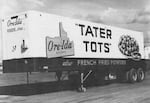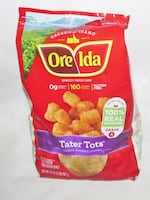When brothers Golden and Francis Nephi “Neef” Grigg began renting a frozen foods plant in the tiny Idaho border town of Ontario, Oregon, in 1949, they were hoping to expand their existing frozen corn business to include potatoes. Little did they know they’d taken the first step toward creating Oregon’s prodigal spud: the tater tot.
A few years after the Griggs converted the flash-freezing plant to a potato-processing facility, the building’s owners went under. The Grigg brothers bought the building they’d been renting out of foreclosure, and in 1952 the company known as Ore-Ida was born.

Ore-Ida Foods advertised its frozen tater tots on the sides of a fleet of 30 trucks and trailer units, shown here in this 1961 photo. The company's "moving billboards" helped drive up sales and increase the popularity of tots.
Wikimedia Commons
In the 1950s, frozen foods were selling like hotcakes. Ore-Ida was the top producer of frozen corn in the country, and French fries were already proving a sound investment. Corn was fairly straightforward, but the downside to processing potatoes was that it was tricky to separate the fries from the scraps — and there were a lot of scraps.
As Kelsey McKinney wrote for Eater in 2017, an equipment salesman happened upon their door, selling a machine for sorting prunes. Nephi and his plant supervisor Slim Burton inquired to the salesman about reconfiguring this machine to handle potatoes and learned that the machine was up to the task. This solved the scrap-sorting problem, but there was still the matter of waste.

A file photo of a bag of Ore-Ida tater tots.
Courtesy Willis Lam / Flickr
The waste products from processing corn into niblets and potatoes into French fries could be offloaded as livestock feed, but unlike corn husks and stripped cobs, leftover potato scraps were technically edible for people, too. The Griggs came up with a solution: chop up those bits, extrude them into logs, blanch them, and coat them in oil to prevent them from sticking together in their freezer bags. Voila, the tater tot.
By 1955, Ore-Ida had already been advertising its frozen diced potatoes and shredded potato patties in earnest, so by the time the tater tot was released a year later, the product was well-positioned to be embraced by American households. Released into grocery stores in 1956, tater tots captured the zeitgeist of midcentury America.
They were easy. Picky kids loved them.
Even in the Mormon community whence the Griggs came, tater tots couldn’t have come at a better time.
According to Washington State University professor emeritus of sociology Armand Mauss, the 1950s saw Mormons pulling away from the wholesome, from-scratch farm fare. They were adopting a more American mainstream cuisine, combining processed, ready-to-eat foods, turning Jell-O and canned fruit cocktails into “salads” or cream-of-whatever soup and frozen potatoes into casseroles.
The only problem was that consumers didn’t trust a product that was essentially made from trash and sold for a song. Raising prices did the trick in boosting sales, and in 1965 the Griggs sold Ore-Ida to Heinz — the makers of tater tots’ best mate, ketchup. In the 1970s, they market-tested a few flavors like cheddar, onion and bacon but eventually returned to their original potato flavor.
By the 1970s, the Midwest had a lock on tater tots as a starchy substrate for casseroles, but decades ago, Oregon perfected another of the tot’s most noble uses: totchos.
Thirty-odd years before Oaks Bottom Public House owner Jim Parker would be credited with their invention, a proto-totcho recipe appeared in The Oregonian, made with a different potato base.

A Portland bar owner is often credited with inventing "totchos," which are tater tots given the nacho treatment.
Courtesy anokarina / Flickr
In her 1983 article “Tater tot keeps elegant company,” Foodday editor Ginger Johnston offers her recipe for “Macho Nachos,” topping frozen cottage fries with jalapeño bean dip, shredded jack cheese and thinly sliced jalapeños, broiled until the cheese is melted.
It would take time for tater tots to take the place of sliced potatoes, but the foundation had been laid. The evolution of the totcho was underway.
Published in 1992, the cookbook Sensibly Thin Low-Fat Living and Cooking offered a recipe for a hamburger casserole with tater tots and canned nacho cheese (no reports on how effective this was as a diet food), but the tater tot’s zenith finally came in 2006.
Invented to prevent food waste, perfected as the ultimate pub grub, the humble tot, born out of Oregon ingenuity, served as-is or adapted to numerous tastes, is now embraced nationwide — and celebrated every year on Feb. 2, for National Tater Tot Day.

Tater tots have become a favorite bar food option and family treat, but the dish has humble roots.
Courtesy of Stuart Spivack / Flickr



